Qualitative Research Design and Data Sources
VerifiedAdded on 2020/01/28
|11
|3843
|175
Literature Review
AI Summary
This assignment focuses on the crucial aspects of designing a qualitative research study. It emphasizes the importance of selecting appropriate data sources, both primary and secondary, to ensure the accuracy and validity of the findings. Understanding how different data sources contribute to a robust research design is essential for conducting meaningful qualitative research.
Contribute Materials
Your contribution can guide someone’s learning journey. Share your
documents today.
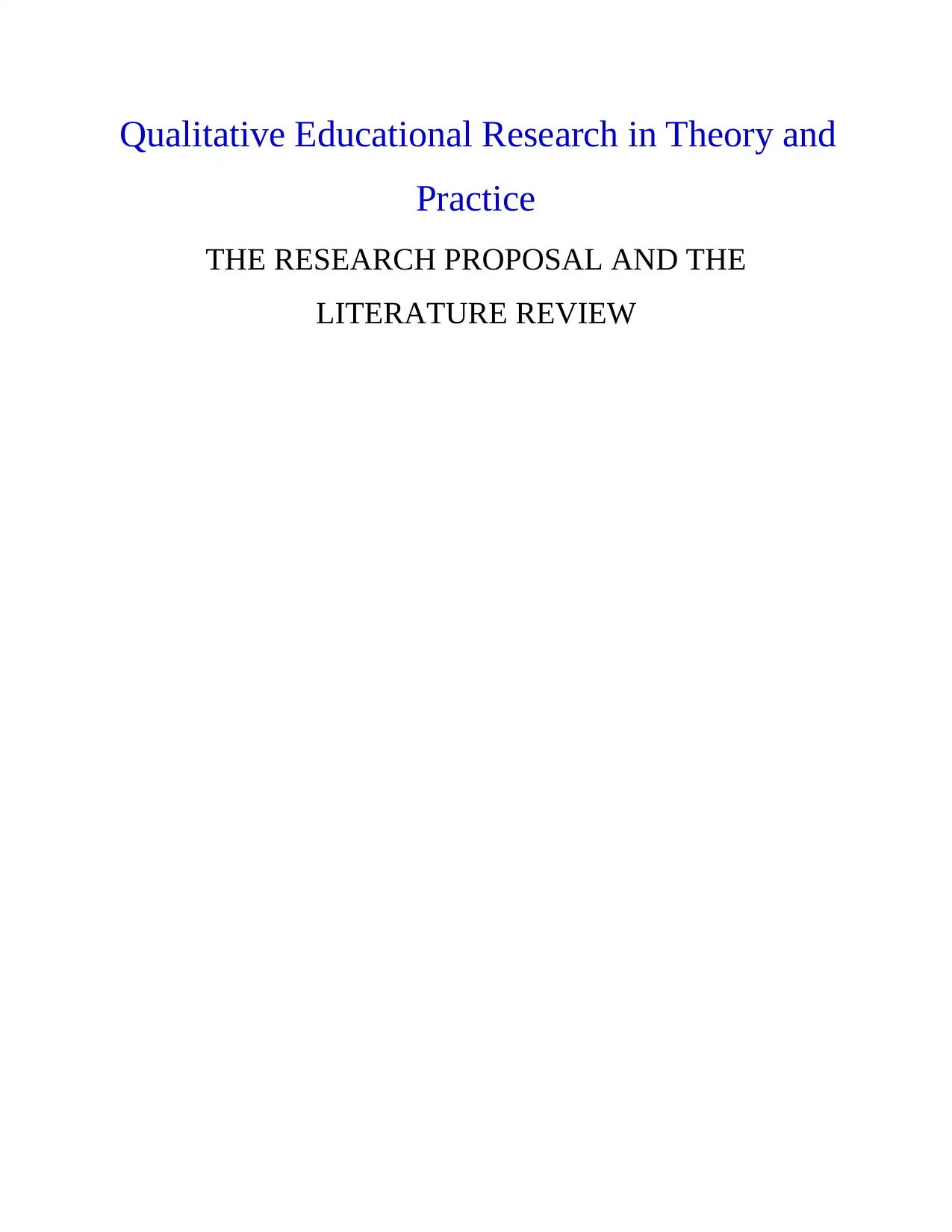
Qualitative Educational Research in Theory and
Practice
THE RESEARCH PROPOSAL AND THE
LITERATURE REVIEW
Practice
THE RESEARCH PROPOSAL AND THE
LITERATURE REVIEW
Secure Best Marks with AI Grader
Need help grading? Try our AI Grader for instant feedback on your assignments.

TABLE OF CONTENTS
Research topic..................................................................................................................................1
Research questions...........................................................................................................................1
Literature review..............................................................................................................................1
The concept of formative and summative assessment.................................................................1
Benefits of formative and summative assessment.......................................................................2
Difference between formative and summative assessment.........................................................3
Effects of formative and summative assessment.........................................................................3
Explaining how and why the research is educational and how qualitative research strategy is
appropriate.......................................................................................................................................4
Research design and data production methods................................................................................6
References........................................................................................................................................8
Research topic..................................................................................................................................1
Research questions...........................................................................................................................1
Literature review..............................................................................................................................1
The concept of formative and summative assessment.................................................................1
Benefits of formative and summative assessment.......................................................................2
Difference between formative and summative assessment.........................................................3
Effects of formative and summative assessment.........................................................................3
Explaining how and why the research is educational and how qualitative research strategy is
appropriate.......................................................................................................................................4
Research design and data production methods................................................................................6
References........................................................................................................................................8
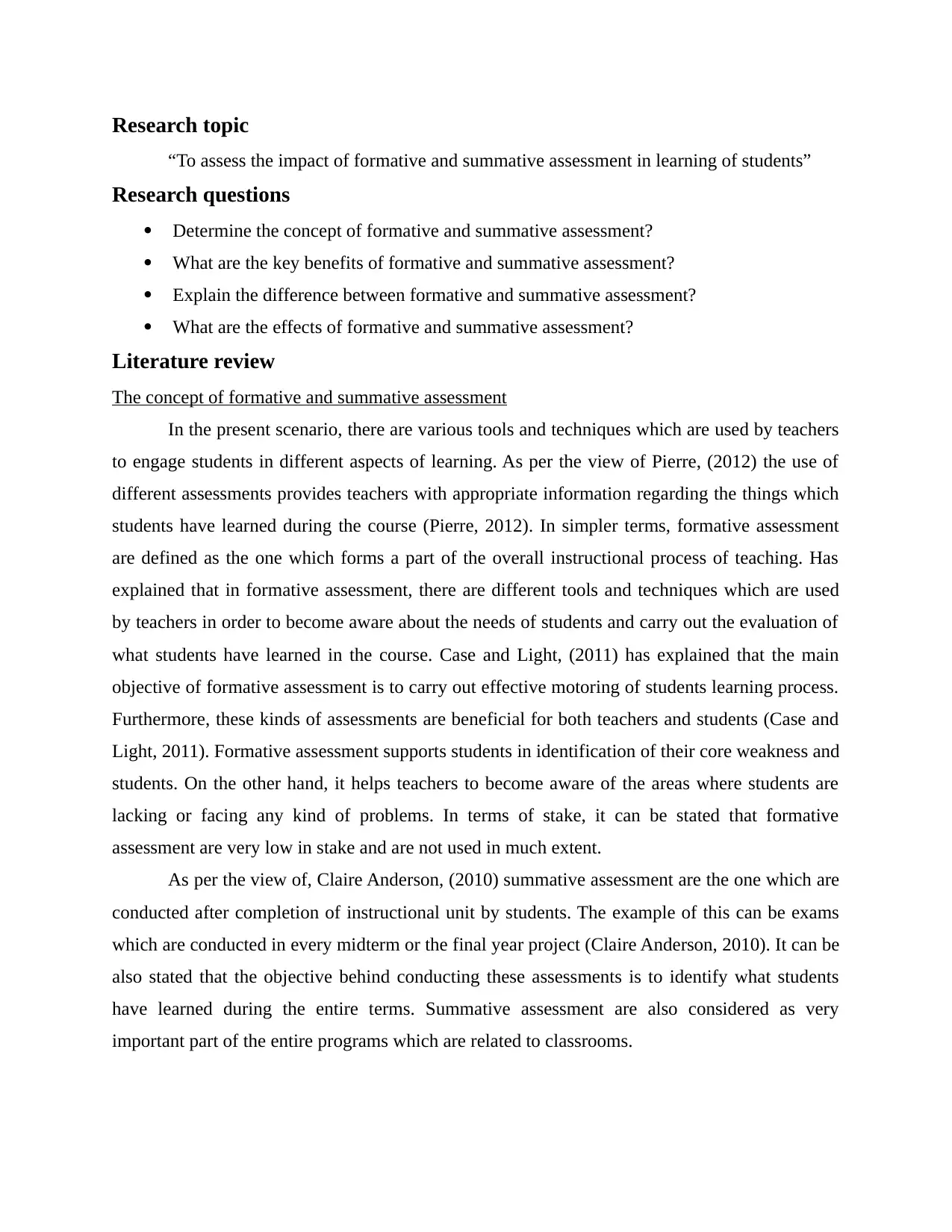
Research topic
“To assess the impact of formative and summative assessment in learning of students”
Research questions
Determine the concept of formative and summative assessment?
What are the key benefits of formative and summative assessment?
Explain the difference between formative and summative assessment?
What are the effects of formative and summative assessment?
Literature review
The concept of formative and summative assessment
In the present scenario, there are various tools and techniques which are used by teachers
to engage students in different aspects of learning. As per the view of Pierre, (2012) the use of
different assessments provides teachers with appropriate information regarding the things which
students have learned during the course (Pierre, 2012). In simpler terms, formative assessment
are defined as the one which forms a part of the overall instructional process of teaching. Has
explained that in formative assessment, there are different tools and techniques which are used
by teachers in order to become aware about the needs of students and carry out the evaluation of
what students have learned in the course. Case and Light, (2011) has explained that the main
objective of formative assessment is to carry out effective motoring of students learning process.
Furthermore, these kinds of assessments are beneficial for both teachers and students (Case and
Light, 2011). Formative assessment supports students in identification of their core weakness and
students. On the other hand, it helps teachers to become aware of the areas where students are
lacking or facing any kind of problems. In terms of stake, it can be stated that formative
assessment are very low in stake and are not used in much extent.
As per the view of, Claire Anderson, (2010) summative assessment are the one which are
conducted after completion of instructional unit by students. The example of this can be exams
which are conducted in every midterm or the final year project (Claire Anderson, 2010). It can be
also stated that the objective behind conducting these assessments is to identify what students
have learned during the entire terms. Summative assessment are also considered as very
important part of the entire programs which are related to classrooms.
“To assess the impact of formative and summative assessment in learning of students”
Research questions
Determine the concept of formative and summative assessment?
What are the key benefits of formative and summative assessment?
Explain the difference between formative and summative assessment?
What are the effects of formative and summative assessment?
Literature review
The concept of formative and summative assessment
In the present scenario, there are various tools and techniques which are used by teachers
to engage students in different aspects of learning. As per the view of Pierre, (2012) the use of
different assessments provides teachers with appropriate information regarding the things which
students have learned during the course (Pierre, 2012). In simpler terms, formative assessment
are defined as the one which forms a part of the overall instructional process of teaching. Has
explained that in formative assessment, there are different tools and techniques which are used
by teachers in order to become aware about the needs of students and carry out the evaluation of
what students have learned in the course. Case and Light, (2011) has explained that the main
objective of formative assessment is to carry out effective motoring of students learning process.
Furthermore, these kinds of assessments are beneficial for both teachers and students (Case and
Light, 2011). Formative assessment supports students in identification of their core weakness and
students. On the other hand, it helps teachers to become aware of the areas where students are
lacking or facing any kind of problems. In terms of stake, it can be stated that formative
assessment are very low in stake and are not used in much extent.
As per the view of, Claire Anderson, (2010) summative assessment are the one which are
conducted after completion of instructional unit by students. The example of this can be exams
which are conducted in every midterm or the final year project (Claire Anderson, 2010). It can be
also stated that the objective behind conducting these assessments is to identify what students
have learned during the entire terms. Summative assessment are also considered as very
important part of the entire programs which are related to classrooms.
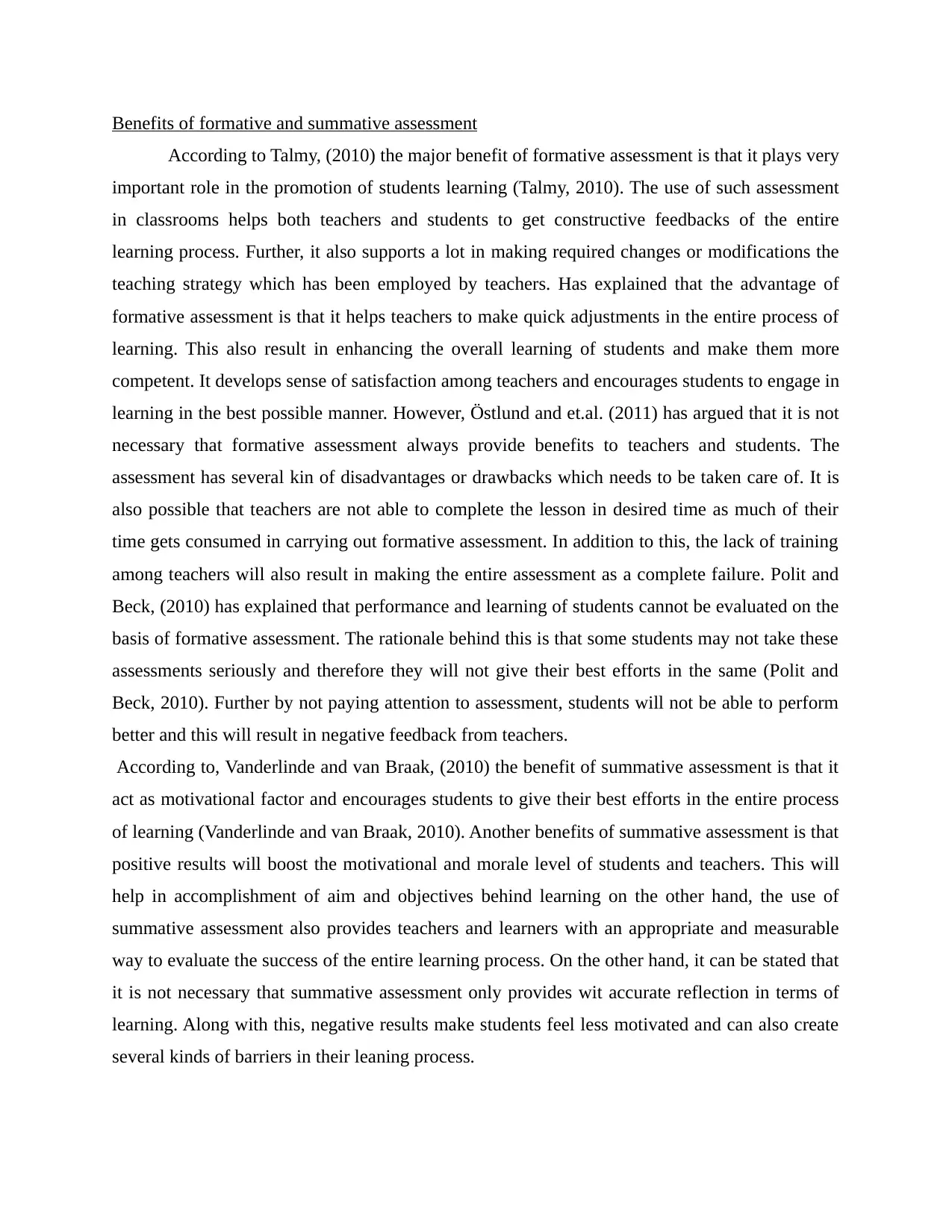
Benefits of formative and summative assessment
According to Talmy, (2010) the major benefit of formative assessment is that it plays very
important role in the promotion of students learning (Talmy, 2010). The use of such assessment
in classrooms helps both teachers and students to get constructive feedbacks of the entire
learning process. Further, it also supports a lot in making required changes or modifications the
teaching strategy which has been employed by teachers. Has explained that the advantage of
formative assessment is that it helps teachers to make quick adjustments in the entire process of
learning. This also result in enhancing the overall learning of students and make them more
competent. It develops sense of satisfaction among teachers and encourages students to engage in
learning in the best possible manner. However, Östlund and et.al. (2011) has argued that it is not
necessary that formative assessment always provide benefits to teachers and students. The
assessment has several kin of disadvantages or drawbacks which needs to be taken care of. It is
also possible that teachers are not able to complete the lesson in desired time as much of their
time gets consumed in carrying out formative assessment. In addition to this, the lack of training
among teachers will also result in making the entire assessment as a complete failure. Polit and
Beck, (2010) has explained that performance and learning of students cannot be evaluated on the
basis of formative assessment. The rationale behind this is that some students may not take these
assessments seriously and therefore they will not give their best efforts in the same (Polit and
Beck, 2010). Further by not paying attention to assessment, students will not be able to perform
better and this will result in negative feedback from teachers.
According to, Vanderlinde and van Braak, (2010) the benefit of summative assessment is that it
act as motivational factor and encourages students to give their best efforts in the entire process
of learning (Vanderlinde and van Braak, 2010). Another benefits of summative assessment is that
positive results will boost the motivational and morale level of students and teachers. This will
help in accomplishment of aim and objectives behind learning on the other hand, the use of
summative assessment also provides teachers and learners with an appropriate and measurable
way to evaluate the success of the entire learning process. On the other hand, it can be stated that
it is not necessary that summative assessment only provides wit accurate reflection in terms of
learning. Along with this, negative results make students feel less motivated and can also create
several kinds of barriers in their leaning process.
According to Talmy, (2010) the major benefit of formative assessment is that it plays very
important role in the promotion of students learning (Talmy, 2010). The use of such assessment
in classrooms helps both teachers and students to get constructive feedbacks of the entire
learning process. Further, it also supports a lot in making required changes or modifications the
teaching strategy which has been employed by teachers. Has explained that the advantage of
formative assessment is that it helps teachers to make quick adjustments in the entire process of
learning. This also result in enhancing the overall learning of students and make them more
competent. It develops sense of satisfaction among teachers and encourages students to engage in
learning in the best possible manner. However, Östlund and et.al. (2011) has argued that it is not
necessary that formative assessment always provide benefits to teachers and students. The
assessment has several kin of disadvantages or drawbacks which needs to be taken care of. It is
also possible that teachers are not able to complete the lesson in desired time as much of their
time gets consumed in carrying out formative assessment. In addition to this, the lack of training
among teachers will also result in making the entire assessment as a complete failure. Polit and
Beck, (2010) has explained that performance and learning of students cannot be evaluated on the
basis of formative assessment. The rationale behind this is that some students may not take these
assessments seriously and therefore they will not give their best efforts in the same (Polit and
Beck, 2010). Further by not paying attention to assessment, students will not be able to perform
better and this will result in negative feedback from teachers.
According to, Vanderlinde and van Braak, (2010) the benefit of summative assessment is that it
act as motivational factor and encourages students to give their best efforts in the entire process
of learning (Vanderlinde and van Braak, 2010). Another benefits of summative assessment is that
positive results will boost the motivational and morale level of students and teachers. This will
help in accomplishment of aim and objectives behind learning on the other hand, the use of
summative assessment also provides teachers and learners with an appropriate and measurable
way to evaluate the success of the entire learning process. On the other hand, it can be stated that
it is not necessary that summative assessment only provides wit accurate reflection in terms of
learning. Along with this, negative results make students feel less motivated and can also create
several kinds of barriers in their leaning process.
Secure Best Marks with AI Grader
Need help grading? Try our AI Grader for instant feedback on your assignments.

Difference between formative and summative assessment
Kincheloe, McLaren and Steinberg, (2011) has asserted that there are various differences
between formative and summative assessment which are organized in the classrooms (Kincheloe,
McLaren and Steinberg, 2011). One of the major differences between the two is that formative
assessment always concentrate on learning process of students and provide ways to make
improvements in the same. On the other side of this, the summative assessment lay more
emphasis on outcomes of students and provides ways to improve the outcome of students.
Another difference is that formative assessment acts as monitoring process for students leaning
whereas summative assessment provides relevant information regarding the fact that what
students have learned in the classroom. Young, (2010) has explained that summative assessment
plays very important role in carrying out appropriate evaluation of students learning whereas
formative assessment results in making the students aware about their key strengths and
weaknesses (Young, 2010). The example of formative assessment are observation, conferences
whereas presentation of report ad final project are some example of summative assessment.
Effects of formative and summative assessment
It can be stated that formative and summative assessment directly affect the overall
learning process of students. In terms of positive effect, it can be stated that these assessments
act as driving force and encourages students to deliver better performance in the class. As per the
view of, it also supports in developing effective strategies which can be beneficial for long term
growth and success. According to Butler-Kisber and Poldma, (2011) the view point of, formative
assessment are considered as more formal. Further, it can be termed as a process not a test which
evaluates the entire learning of students (Butler-Kisber and Poldma, 2011). The effects of
formative assessment is that it makes teachers and students aware about three important areas
which are where they have planned to go, where they are and how they can close the gap
between actual and desired performance. Another effect of formative assessment is that teachers
are able to clarify success and intention behind the process of learning. On the other hand, if the
students are not able to perform better, summative assessment helps teachers to make appropriate
changes in their style and method of teaching which can be used for the next academic year
(Harper, 2012). Summative assessment can negative effect some students in the class. Those
students which achieves low grade in class started feeling less motivated and their self image
also gets lower down. Another effect is that summative assessments only provide insight
Kincheloe, McLaren and Steinberg, (2011) has asserted that there are various differences
between formative and summative assessment which are organized in the classrooms (Kincheloe,
McLaren and Steinberg, 2011). One of the major differences between the two is that formative
assessment always concentrate on learning process of students and provide ways to make
improvements in the same. On the other side of this, the summative assessment lay more
emphasis on outcomes of students and provides ways to improve the outcome of students.
Another difference is that formative assessment acts as monitoring process for students leaning
whereas summative assessment provides relevant information regarding the fact that what
students have learned in the classroom. Young, (2010) has explained that summative assessment
plays very important role in carrying out appropriate evaluation of students learning whereas
formative assessment results in making the students aware about their key strengths and
weaknesses (Young, 2010). The example of formative assessment are observation, conferences
whereas presentation of report ad final project are some example of summative assessment.
Effects of formative and summative assessment
It can be stated that formative and summative assessment directly affect the overall
learning process of students. In terms of positive effect, it can be stated that these assessments
act as driving force and encourages students to deliver better performance in the class. As per the
view of, it also supports in developing effective strategies which can be beneficial for long term
growth and success. According to Butler-Kisber and Poldma, (2011) the view point of, formative
assessment are considered as more formal. Further, it can be termed as a process not a test which
evaluates the entire learning of students (Butler-Kisber and Poldma, 2011). The effects of
formative assessment is that it makes teachers and students aware about three important areas
which are where they have planned to go, where they are and how they can close the gap
between actual and desired performance. Another effect of formative assessment is that teachers
are able to clarify success and intention behind the process of learning. On the other hand, if the
students are not able to perform better, summative assessment helps teachers to make appropriate
changes in their style and method of teaching which can be used for the next academic year
(Harper, 2012). Summative assessment can negative effect some students in the class. Those
students which achieves low grade in class started feeling less motivated and their self image
also gets lower down. Another effect is that summative assessments only provide insight

regrading the fact that what students have learned in the class. In terms of positive effects it can
be stated that it motivates students and also assist them in getting good marks in the future. It is
the responsibility of teachers to make sure that students are not affected in bad sense when they
are face negative outcomes of the assessment. Further, they are personally required to deal with
students and make the aware of the areas where they are lacking. Teachers also need to make
changes in their teaching style and strategies so that more and more students can obtain good
marks (Hannes, Lockwood and Pearson, 2010). At the time of carrying out the process of
teaching, a flexible strategy and style is required to be adopted by teachers. The reason behind
this is that such a kind of strategy will support in making appropriate changes in structure as per
the requirements. It can be stated that success of class cannot be achieved with the efforts of
teachers and students are required to cooperate with teachers (Qu and Dumay, 2011). They need
to understand the value of knowledge and information which has been provided by teachers. In
addition to this, they are also required to put many efforts to obtain the best possible outcomes.
Explaining how and why the research is educational and how qualitative
research strategy is appropriate
The research will be based on assessing the impact of formative and summative
assessments in learning of students. The researcher has selected topic which is entirely linked
with the field of education. In the present scenario, it has become very difficult for teachers to
enhance the learning and performance of students in class. Along with this, nowadays it is also
required by teachers to use variety of teaching tools and strategies to get the favourable outcome.
Most of the times, the size and strengths of class is very large and therefore it becomes very
difficult for teachers to identify whether students are learning easily or not. In addition to this,
teachers are also required to put large amount of efforts to make students learn new things and
enhance their knowledge. The problem arise when teachers are not able to determine effective
tools through which they can assess the performance of students. Due to these aspects, teachers
have started using tools such as formative and summative assessment. The use of these
assessments at regular intervals is not only beneficial for teachers but also provides different type
of advantages to students in the class. The topic which has been selected is entirely related to
education as it covers two different forms of evaluating the learning of students. It also takes
teachers and students into consideration and these are the two main areas in education. The
be stated that it motivates students and also assist them in getting good marks in the future. It is
the responsibility of teachers to make sure that students are not affected in bad sense when they
are face negative outcomes of the assessment. Further, they are personally required to deal with
students and make the aware of the areas where they are lacking. Teachers also need to make
changes in their teaching style and strategies so that more and more students can obtain good
marks (Hannes, Lockwood and Pearson, 2010). At the time of carrying out the process of
teaching, a flexible strategy and style is required to be adopted by teachers. The reason behind
this is that such a kind of strategy will support in making appropriate changes in structure as per
the requirements. It can be stated that success of class cannot be achieved with the efforts of
teachers and students are required to cooperate with teachers (Qu and Dumay, 2011). They need
to understand the value of knowledge and information which has been provided by teachers. In
addition to this, they are also required to put many efforts to obtain the best possible outcomes.
Explaining how and why the research is educational and how qualitative
research strategy is appropriate
The research will be based on assessing the impact of formative and summative
assessments in learning of students. The researcher has selected topic which is entirely linked
with the field of education. In the present scenario, it has become very difficult for teachers to
enhance the learning and performance of students in class. Along with this, nowadays it is also
required by teachers to use variety of teaching tools and strategies to get the favourable outcome.
Most of the times, the size and strengths of class is very large and therefore it becomes very
difficult for teachers to identify whether students are learning easily or not. In addition to this,
teachers are also required to put large amount of efforts to make students learn new things and
enhance their knowledge. The problem arise when teachers are not able to determine effective
tools through which they can assess the performance of students. Due to these aspects, teachers
have started using tools such as formative and summative assessment. The use of these
assessments at regular intervals is not only beneficial for teachers but also provides different type
of advantages to students in the class. The topic which has been selected is entirely related to
education as it covers two different forms of evaluating the learning of students. It also takes
teachers and students into consideration and these are the two main areas in education. The
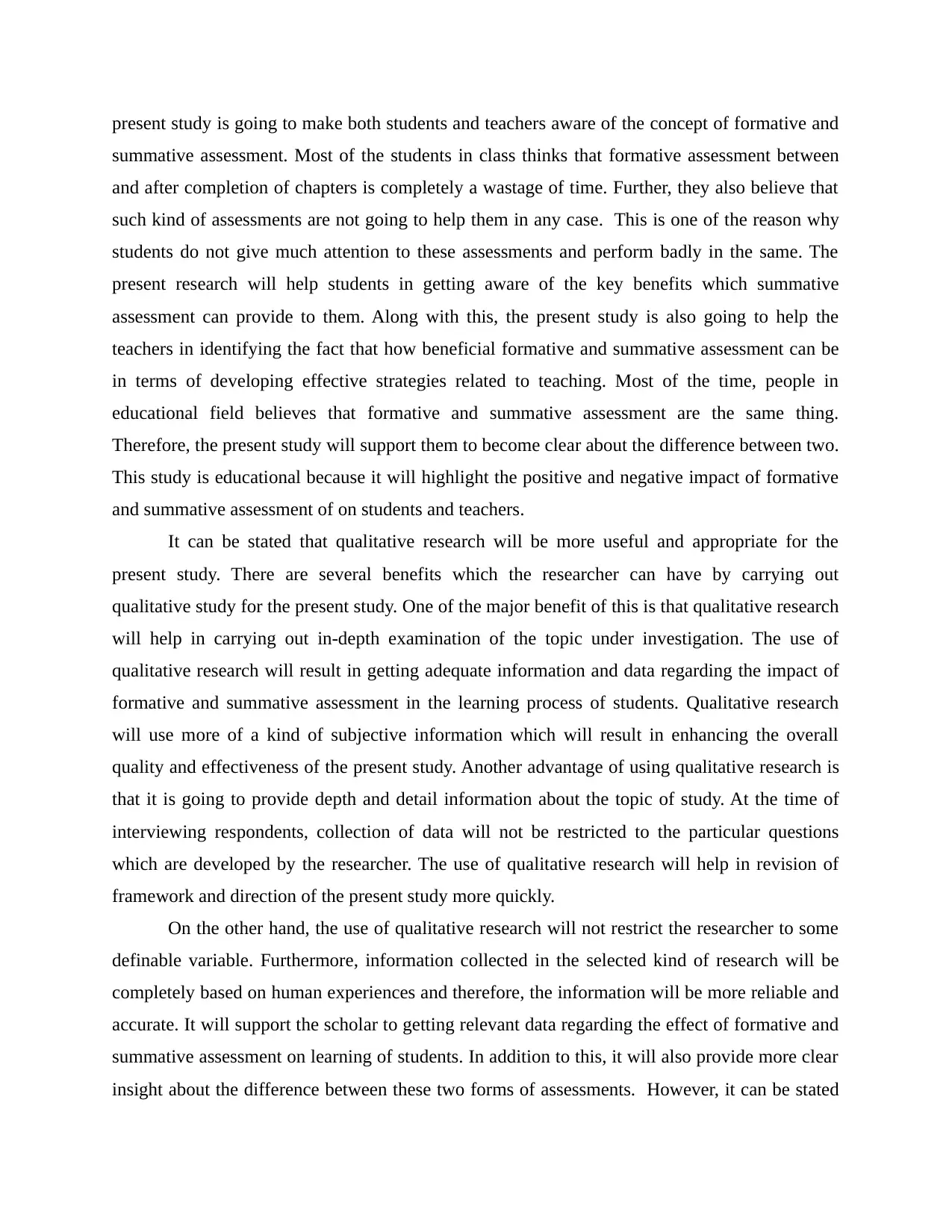
present study is going to make both students and teachers aware of the concept of formative and
summative assessment. Most of the students in class thinks that formative assessment between
and after completion of chapters is completely a wastage of time. Further, they also believe that
such kind of assessments are not going to help them in any case. This is one of the reason why
students do not give much attention to these assessments and perform badly in the same. The
present research will help students in getting aware of the key benefits which summative
assessment can provide to them. Along with this, the present study is also going to help the
teachers in identifying the fact that how beneficial formative and summative assessment can be
in terms of developing effective strategies related to teaching. Most of the time, people in
educational field believes that formative and summative assessment are the same thing.
Therefore, the present study will support them to become clear about the difference between two.
This study is educational because it will highlight the positive and negative impact of formative
and summative assessment of on students and teachers.
It can be stated that qualitative research will be more useful and appropriate for the
present study. There are several benefits which the researcher can have by carrying out
qualitative study for the present study. One of the major benefit of this is that qualitative research
will help in carrying out in-depth examination of the topic under investigation. The use of
qualitative research will result in getting adequate information and data regarding the impact of
formative and summative assessment in the learning process of students. Qualitative research
will use more of a kind of subjective information which will result in enhancing the overall
quality and effectiveness of the present study. Another advantage of using qualitative research is
that it is going to provide depth and detail information about the topic of study. At the time of
interviewing respondents, collection of data will not be restricted to the particular questions
which are developed by the researcher. The use of qualitative research will help in revision of
framework and direction of the present study more quickly.
On the other hand, the use of qualitative research will not restrict the researcher to some
definable variable. Furthermore, information collected in the selected kind of research will be
completely based on human experiences and therefore, the information will be more reliable and
accurate. It will support the scholar to getting relevant data regarding the effect of formative and
summative assessment on learning of students. In addition to this, it will also provide more clear
insight about the difference between these two forms of assessments. However, it can be stated
summative assessment. Most of the students in class thinks that formative assessment between
and after completion of chapters is completely a wastage of time. Further, they also believe that
such kind of assessments are not going to help them in any case. This is one of the reason why
students do not give much attention to these assessments and perform badly in the same. The
present research will help students in getting aware of the key benefits which summative
assessment can provide to them. Along with this, the present study is also going to help the
teachers in identifying the fact that how beneficial formative and summative assessment can be
in terms of developing effective strategies related to teaching. Most of the time, people in
educational field believes that formative and summative assessment are the same thing.
Therefore, the present study will support them to become clear about the difference between two.
This study is educational because it will highlight the positive and negative impact of formative
and summative assessment of on students and teachers.
It can be stated that qualitative research will be more useful and appropriate for the
present study. There are several benefits which the researcher can have by carrying out
qualitative study for the present study. One of the major benefit of this is that qualitative research
will help in carrying out in-depth examination of the topic under investigation. The use of
qualitative research will result in getting adequate information and data regarding the impact of
formative and summative assessment in the learning process of students. Qualitative research
will use more of a kind of subjective information which will result in enhancing the overall
quality and effectiveness of the present study. Another advantage of using qualitative research is
that it is going to provide depth and detail information about the topic of study. At the time of
interviewing respondents, collection of data will not be restricted to the particular questions
which are developed by the researcher. The use of qualitative research will help in revision of
framework and direction of the present study more quickly.
On the other hand, the use of qualitative research will not restrict the researcher to some
definable variable. Furthermore, information collected in the selected kind of research will be
completely based on human experiences and therefore, the information will be more reliable and
accurate. It will support the scholar to getting relevant data regarding the effect of formative and
summative assessment on learning of students. In addition to this, it will also provide more clear
insight about the difference between these two forms of assessments. However, it can be stated
Paraphrase This Document
Need a fresh take? Get an instant paraphrase of this document with our AI Paraphraser

that there are some drawbacks and disadvantages of using qualitative research and the scholar is
required to take care of the same. Carrying out such kind of research is not an easy task and
effective qualitative research demand heavy skills and knowledge regarding the same. The
success of research will depend on the skills which the research is having. Furthermore, the data
which will be provided by qualitative research can be considered as time consuming and it will
not be easy for the researcher to carry out the evaluating of the information collected. All these
factors will be required to take care of by the researcher at the time of carrying out the present
study. It can be also argued that for the present study or as per the nature of current study, the use
of qualitative research is going to be more effective. The rationale behind this is that it will
support in getting detail about the emotions and behaviour human nature in terms of impact of
formative and summative assessment in learning process. The use of quantitative research will
not provide the scholar with same kind of relevant information and data. Furthermore, less
amount of human, financial and technological resources will be required in situation where the
researcher makes the use of qualitative research. Along with this, using qualitative research will
help the scholar in getting aware of different ways through which the process of data collection,
analysis and interpretation can be carried out in most effective manner. Flexibility will also play
very important role in making changes in any of the process as per need and demand of the
researcher.
Research design and data production methods
In order to carry out the present research, case study research design will be adopted by
the scholar. Furthermore, it can be stated that in last few years, case study design has emerged
and developed as one of the effective tool in carrying out a particular study in appropriate
manner. The reason why this research design is effective is that it provide a detail insight about
topic under investigation. In addition to this, it also plays very important role in getting accurate
and more reliable information. It is a kind of research design which lay emphasis on acquiring
knowledge regarding a particular subject by looking deeply into a particular event which has
happened during a particular point of time. For the present study various cases of classrooms will
be taken into consideration to gain knowledge about the fact that what kind of impact does
formative and summative assessment has in the entire learning process of the students. The use
of case study research design will help the researcher in the collecting data from various sources.
required to take care of the same. Carrying out such kind of research is not an easy task and
effective qualitative research demand heavy skills and knowledge regarding the same. The
success of research will depend on the skills which the research is having. Furthermore, the data
which will be provided by qualitative research can be considered as time consuming and it will
not be easy for the researcher to carry out the evaluating of the information collected. All these
factors will be required to take care of by the researcher at the time of carrying out the present
study. It can be also argued that for the present study or as per the nature of current study, the use
of qualitative research is going to be more effective. The rationale behind this is that it will
support in getting detail about the emotions and behaviour human nature in terms of impact of
formative and summative assessment in learning process. The use of quantitative research will
not provide the scholar with same kind of relevant information and data. Furthermore, less
amount of human, financial and technological resources will be required in situation where the
researcher makes the use of qualitative research. Along with this, using qualitative research will
help the scholar in getting aware of different ways through which the process of data collection,
analysis and interpretation can be carried out in most effective manner. Flexibility will also play
very important role in making changes in any of the process as per need and demand of the
researcher.
Research design and data production methods
In order to carry out the present research, case study research design will be adopted by
the scholar. Furthermore, it can be stated that in last few years, case study design has emerged
and developed as one of the effective tool in carrying out a particular study in appropriate
manner. The reason why this research design is effective is that it provide a detail insight about
topic under investigation. In addition to this, it also plays very important role in getting accurate
and more reliable information. It is a kind of research design which lay emphasis on acquiring
knowledge regarding a particular subject by looking deeply into a particular event which has
happened during a particular point of time. For the present study various cases of classrooms will
be taken into consideration to gain knowledge about the fact that what kind of impact does
formative and summative assessment has in the entire learning process of the students. The use
of case study research design will help the researcher in the collecting data from various sources.
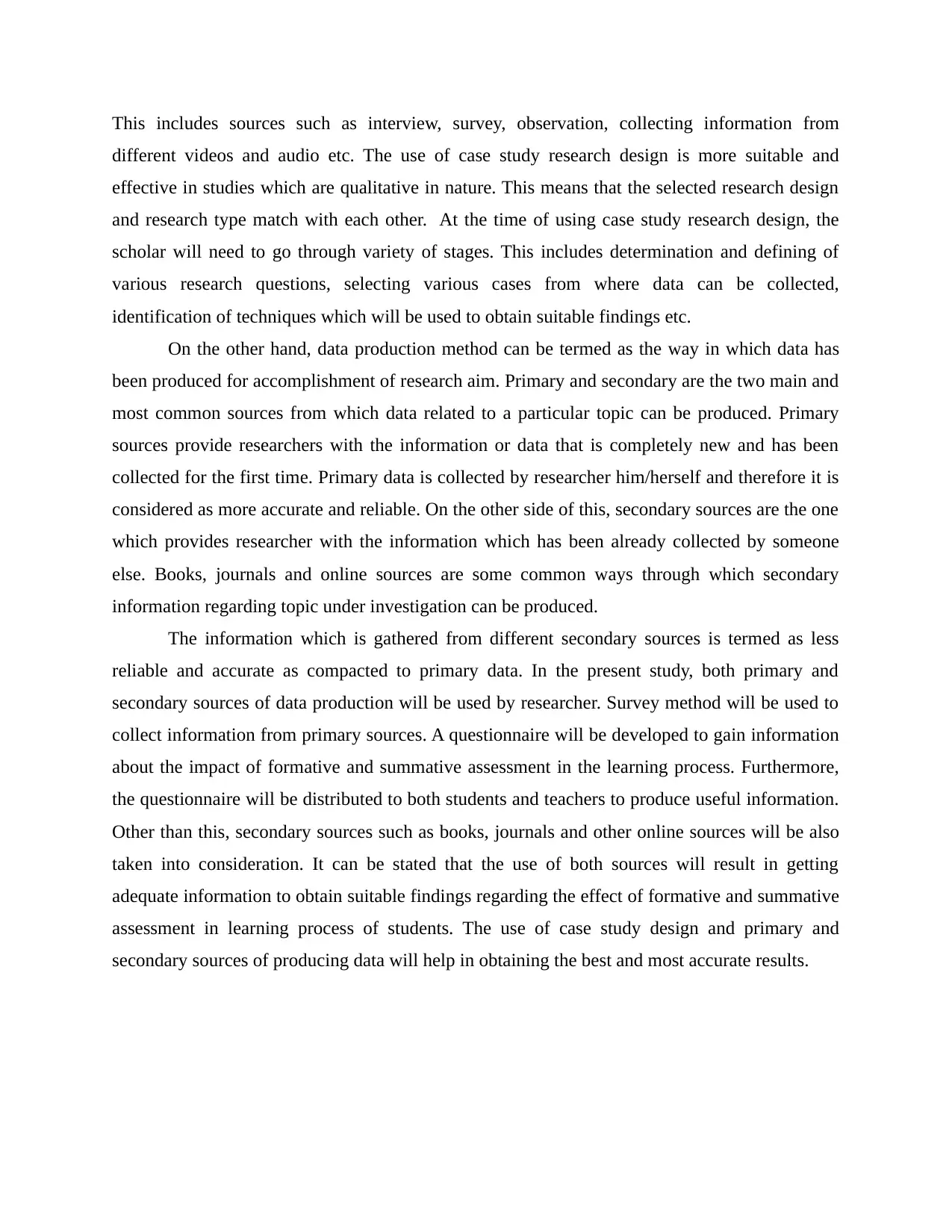
This includes sources such as interview, survey, observation, collecting information from
different videos and audio etc. The use of case study research design is more suitable and
effective in studies which are qualitative in nature. This means that the selected research design
and research type match with each other. At the time of using case study research design, the
scholar will need to go through variety of stages. This includes determination and defining of
various research questions, selecting various cases from where data can be collected,
identification of techniques which will be used to obtain suitable findings etc.
On the other hand, data production method can be termed as the way in which data has
been produced for accomplishment of research aim. Primary and secondary are the two main and
most common sources from which data related to a particular topic can be produced. Primary
sources provide researchers with the information or data that is completely new and has been
collected for the first time. Primary data is collected by researcher him/herself and therefore it is
considered as more accurate and reliable. On the other side of this, secondary sources are the one
which provides researcher with the information which has been already collected by someone
else. Books, journals and online sources are some common ways through which secondary
information regarding topic under investigation can be produced.
The information which is gathered from different secondary sources is termed as less
reliable and accurate as compacted to primary data. In the present study, both primary and
secondary sources of data production will be used by researcher. Survey method will be used to
collect information from primary sources. A questionnaire will be developed to gain information
about the impact of formative and summative assessment in the learning process. Furthermore,
the questionnaire will be distributed to both students and teachers to produce useful information.
Other than this, secondary sources such as books, journals and other online sources will be also
taken into consideration. It can be stated that the use of both sources will result in getting
adequate information to obtain suitable findings regarding the effect of formative and summative
assessment in learning process of students. The use of case study design and primary and
secondary sources of producing data will help in obtaining the best and most accurate results.
different videos and audio etc. The use of case study research design is more suitable and
effective in studies which are qualitative in nature. This means that the selected research design
and research type match with each other. At the time of using case study research design, the
scholar will need to go through variety of stages. This includes determination and defining of
various research questions, selecting various cases from where data can be collected,
identification of techniques which will be used to obtain suitable findings etc.
On the other hand, data production method can be termed as the way in which data has
been produced for accomplishment of research aim. Primary and secondary are the two main and
most common sources from which data related to a particular topic can be produced. Primary
sources provide researchers with the information or data that is completely new and has been
collected for the first time. Primary data is collected by researcher him/herself and therefore it is
considered as more accurate and reliable. On the other side of this, secondary sources are the one
which provides researcher with the information which has been already collected by someone
else. Books, journals and online sources are some common ways through which secondary
information regarding topic under investigation can be produced.
The information which is gathered from different secondary sources is termed as less
reliable and accurate as compacted to primary data. In the present study, both primary and
secondary sources of data production will be used by researcher. Survey method will be used to
collect information from primary sources. A questionnaire will be developed to gain information
about the impact of formative and summative assessment in the learning process. Furthermore,
the questionnaire will be distributed to both students and teachers to produce useful information.
Other than this, secondary sources such as books, journals and other online sources will be also
taken into consideration. It can be stated that the use of both sources will result in getting
adequate information to obtain suitable findings regarding the effect of formative and summative
assessment in learning process of students. The use of case study design and primary and
secondary sources of producing data will help in obtaining the best and most accurate results.
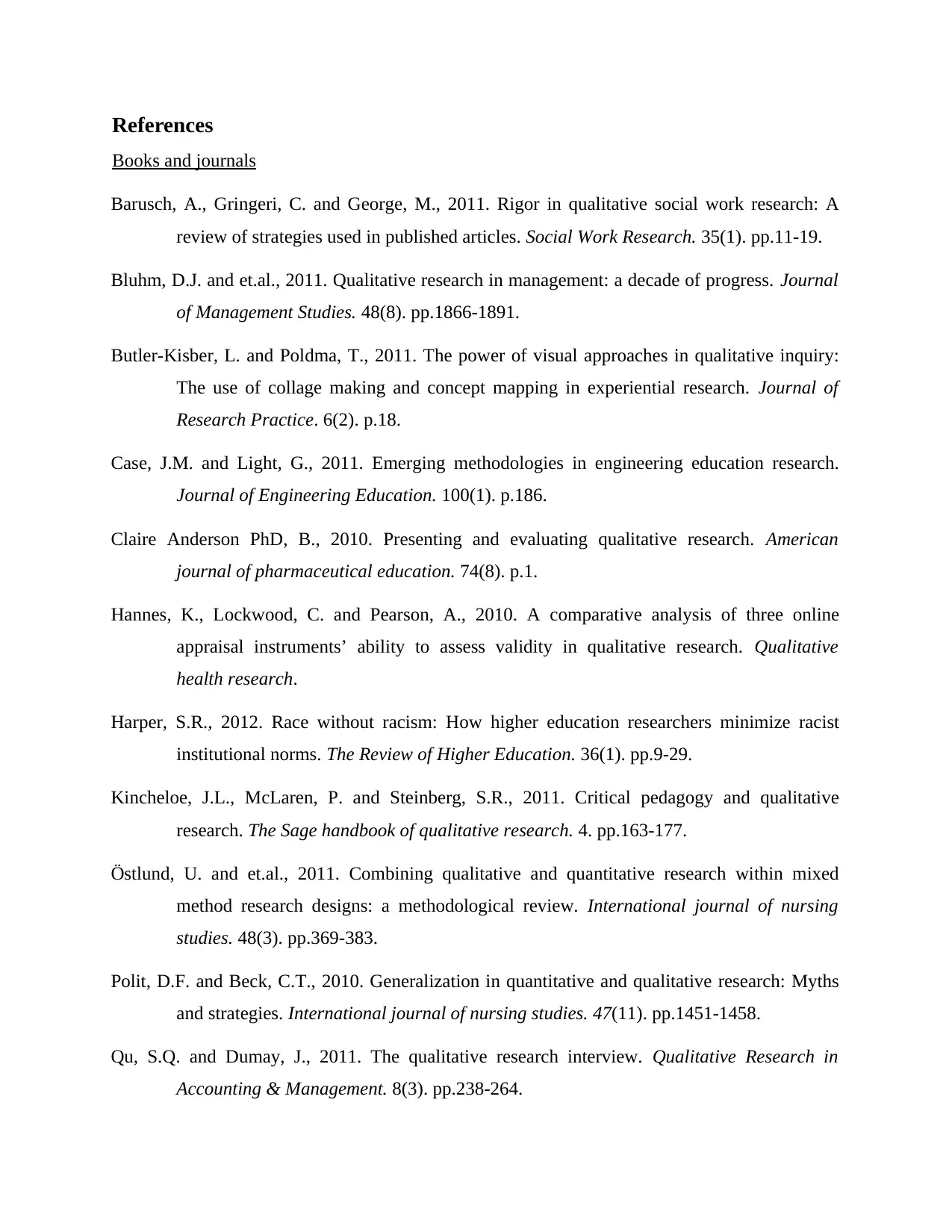
References
Books and journals
Barusch, A., Gringeri, C. and George, M., 2011. Rigor in qualitative social work research: A
review of strategies used in published articles. Social Work Research. 35(1). pp.11-19.
Bluhm, D.J. and et.al., 2011. Qualitative research in management: a decade of progress. Journal
of Management Studies. 48(8). pp.1866-1891.
Butler-Kisber, L. and Poldma, T., 2011. The power of visual approaches in qualitative inquiry:
The use of collage making and concept mapping in experiential research. Journal of
Research Practice. 6(2). p.18.
Case, J.M. and Light, G., 2011. Emerging methodologies in engineering education research.
Journal of Engineering Education. 100(1). p.186.
Claire Anderson PhD, B., 2010. Presenting and evaluating qualitative research. American
journal of pharmaceutical education. 74(8). p.1.
Hannes, K., Lockwood, C. and Pearson, A., 2010. A comparative analysis of three online
appraisal instruments’ ability to assess validity in qualitative research. Qualitative
health research.
Harper, S.R., 2012. Race without racism: How higher education researchers minimize racist
institutional norms. The Review of Higher Education. 36(1). pp.9-29.
Kincheloe, J.L., McLaren, P. and Steinberg, S.R., 2011. Critical pedagogy and qualitative
research. The Sage handbook of qualitative research. 4. pp.163-177.
Östlund, U. and et.al., 2011. Combining qualitative and quantitative research within mixed
method research designs: a methodological review. International journal of nursing
studies. 48(3). pp.369-383.
Polit, D.F. and Beck, C.T., 2010. Generalization in quantitative and qualitative research: Myths
and strategies. International journal of nursing studies. 47(11). pp.1451-1458.
Qu, S.Q. and Dumay, J., 2011. The qualitative research interview. Qualitative Research in
Accounting & Management. 8(3). pp.238-264.
Books and journals
Barusch, A., Gringeri, C. and George, M., 2011. Rigor in qualitative social work research: A
review of strategies used in published articles. Social Work Research. 35(1). pp.11-19.
Bluhm, D.J. and et.al., 2011. Qualitative research in management: a decade of progress. Journal
of Management Studies. 48(8). pp.1866-1891.
Butler-Kisber, L. and Poldma, T., 2011. The power of visual approaches in qualitative inquiry:
The use of collage making and concept mapping in experiential research. Journal of
Research Practice. 6(2). p.18.
Case, J.M. and Light, G., 2011. Emerging methodologies in engineering education research.
Journal of Engineering Education. 100(1). p.186.
Claire Anderson PhD, B., 2010. Presenting and evaluating qualitative research. American
journal of pharmaceutical education. 74(8). p.1.
Hannes, K., Lockwood, C. and Pearson, A., 2010. A comparative analysis of three online
appraisal instruments’ ability to assess validity in qualitative research. Qualitative
health research.
Harper, S.R., 2012. Race without racism: How higher education researchers minimize racist
institutional norms. The Review of Higher Education. 36(1). pp.9-29.
Kincheloe, J.L., McLaren, P. and Steinberg, S.R., 2011. Critical pedagogy and qualitative
research. The Sage handbook of qualitative research. 4. pp.163-177.
Östlund, U. and et.al., 2011. Combining qualitative and quantitative research within mixed
method research designs: a methodological review. International journal of nursing
studies. 48(3). pp.369-383.
Polit, D.F. and Beck, C.T., 2010. Generalization in quantitative and qualitative research: Myths
and strategies. International journal of nursing studies. 47(11). pp.1451-1458.
Qu, S.Q. and Dumay, J., 2011. The qualitative research interview. Qualitative Research in
Accounting & Management. 8(3). pp.238-264.
Secure Best Marks with AI Grader
Need help grading? Try our AI Grader for instant feedback on your assignments.
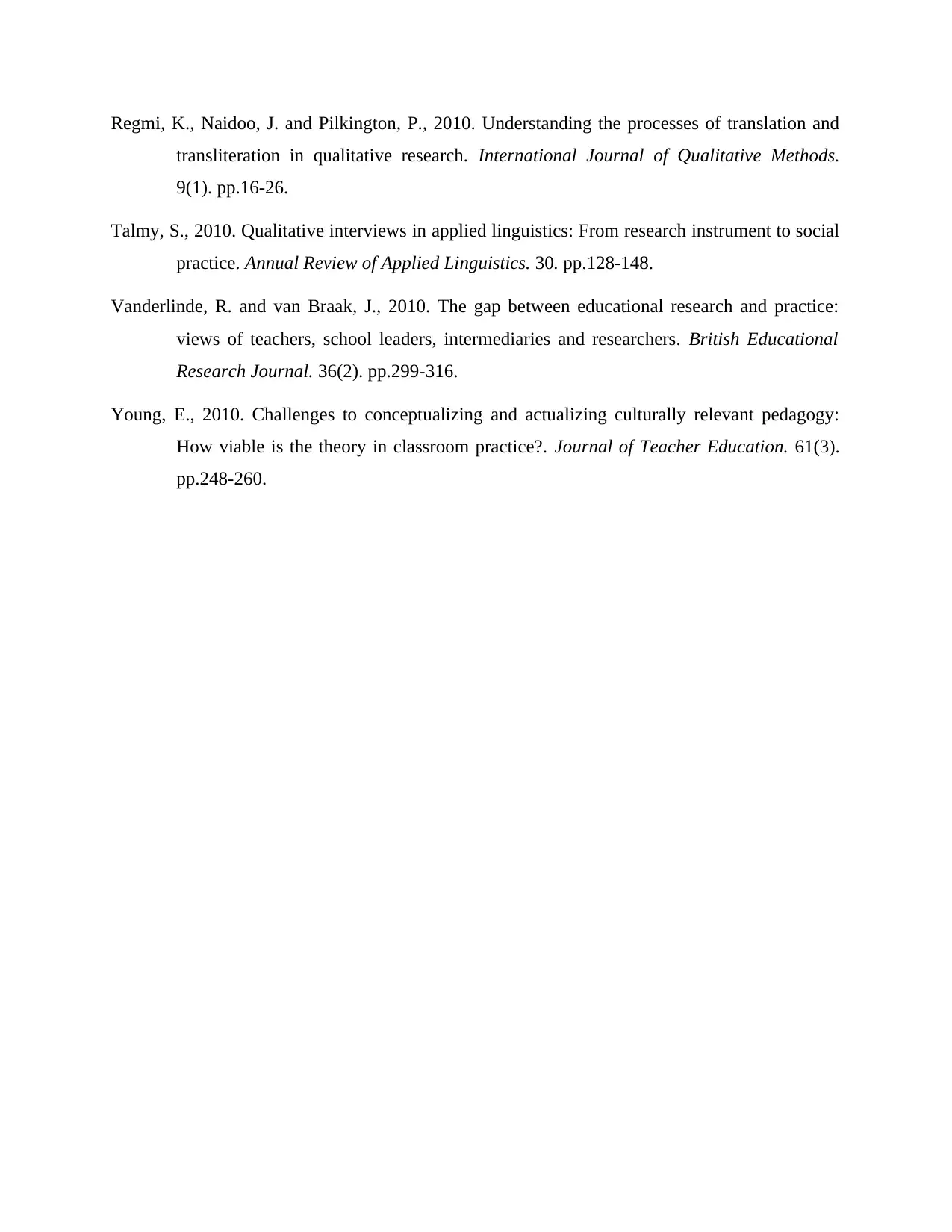
Regmi, K., Naidoo, J. and Pilkington, P., 2010. Understanding the processes of translation and
transliteration in qualitative research. International Journal of Qualitative Methods.
9(1). pp.16-26.
Talmy, S., 2010. Qualitative interviews in applied linguistics: From research instrument to social
practice. Annual Review of Applied Linguistics. 30. pp.128-148.
Vanderlinde, R. and van Braak, J., 2010. The gap between educational research and practice:
views of teachers, school leaders, intermediaries and researchers. British Educational
Research Journal. 36(2). pp.299-316.
Young, E., 2010. Challenges to conceptualizing and actualizing culturally relevant pedagogy:
How viable is the theory in classroom practice?. Journal of Teacher Education. 61(3).
pp.248-260.
transliteration in qualitative research. International Journal of Qualitative Methods.
9(1). pp.16-26.
Talmy, S., 2010. Qualitative interviews in applied linguistics: From research instrument to social
practice. Annual Review of Applied Linguistics. 30. pp.128-148.
Vanderlinde, R. and van Braak, J., 2010. The gap between educational research and practice:
views of teachers, school leaders, intermediaries and researchers. British Educational
Research Journal. 36(2). pp.299-316.
Young, E., 2010. Challenges to conceptualizing and actualizing culturally relevant pedagogy:
How viable is the theory in classroom practice?. Journal of Teacher Education. 61(3).
pp.248-260.
1 out of 11
Related Documents
Your All-in-One AI-Powered Toolkit for Academic Success.
+13062052269
info@desklib.com
Available 24*7 on WhatsApp / Email
![[object Object]](/_next/static/media/star-bottom.7253800d.svg)
Unlock your academic potential
© 2024 | Zucol Services PVT LTD | All rights reserved.





